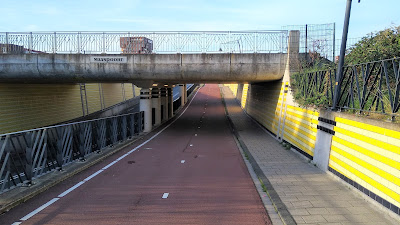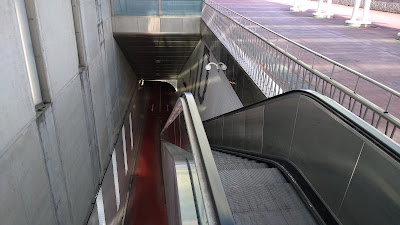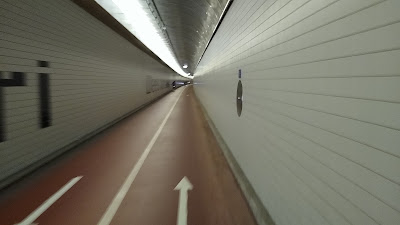As 2022 draws to a close, I thought I'd round off the year with a final visit to the Netherlands in the third and final part of a short series. This time, I'm going in search of some Dutch hills.
Large parts of the Netherlands is pretty flat in terms of landform, although the east of the country would take issue with this. Anyone who has cycled there (especially nearer the coast) will also be able to attest to the wind which is often called the Dutch hill, but I'm on the hunt for infrastructure and my travels in the Rotterdam area didn't disappoint.
You might recall that I mentioned the Van Brienenoordbrug bridge in the first post of this series and it's worth another mention given how high it rises above the Nieuwe Mass river. The photograph above was taken from the northeast side and shows just how long and high the approach viaduct is. I shot a little bit of video to show the steepness as I struggled up on my three-speed bicycle in the wind.
This is a theme for the Netherlands. For its apparent flatness, there are plenty of man-made and natural barriers which need to be crossed. From a cycling (and walking) point of view, the most comfortable solutions don't require a change in level, but where levels are more fixed, such as crossing railways, then localised hills (and dips) will need to be created.
The photograph above is a road-rail crossing on the edge of Maassluis, to the west of Rotterdam. The underpass connects to a residential extension to the town and was under construction in 2010.
The photograph above is a closer view of the underpass where you can see the road is dipped much more severely than the cycle track and footway simply because the latter require far less headroom. All being equal with levels more generally, the underpass approach means far shorter ramps and a smaller change in level for those travelling under their own steam than a bridge where all modes have to clear the obstacle in the same way.
Sometimes the levels can be a little tricky to work out, but the underpass above and the cycle track running through it is pretty much at the original ground level. It is the tangle of roads of the Rotterdam-Feijenoord junction which are raised with the motors doing the work. What little slope there is in this little piece of the cycling network is very gentle and easy to use.
Sometimes, though, the change in level is so great and space is so tight that a bit of mechanical help is needed. The Benelux Cycle Tunnel (above), runs next to the A4 motorway and was built in 2002 as part of a transport upgrade which also saw a metro line added.
The tunnel is under the Nieuwe Mass river and has very prominent station-like entrances which give direct access to the employment and residential districts on both sides of the river. Rather than having very long ramps, the tunnel has lifts and escalators (above) for access under the entrances which take you down to the tunnel. As it heads towards the centre of the river, there is a long slope down, but inevitably, this turns into a long slope up which still takes a bit of effort (below).
Without the lifts and escalators, the ramps would be incredibly long and for those wanting to access the land on both sides of the river, they would then have to cycle back on themselves for some distance. The mechanical help was very much appreciated!
There is a long running and very boring trope we get in the UK that the Dutch cycle because it's flat. It is obviously nonsense. The real reason that the Dutch cycle is that there has been a continual plan of work to provide a cycling network which operates independently of the motoring network. Where the two meet, interactions are carefully managed or they simply share the same alignment such as the Erasmusbrug in Rotterdam (above and below) which was completed in 1996 and creates another hill over the Nieuwe Maas.
Well that's it for 2022 and my little Dutch series. This blog will be back in 2023 where I am looking forward to looking at more infrastructure, more places and testing a few more ideas and concepts. Happy New Year to you all.











No comments:
Post a Comment